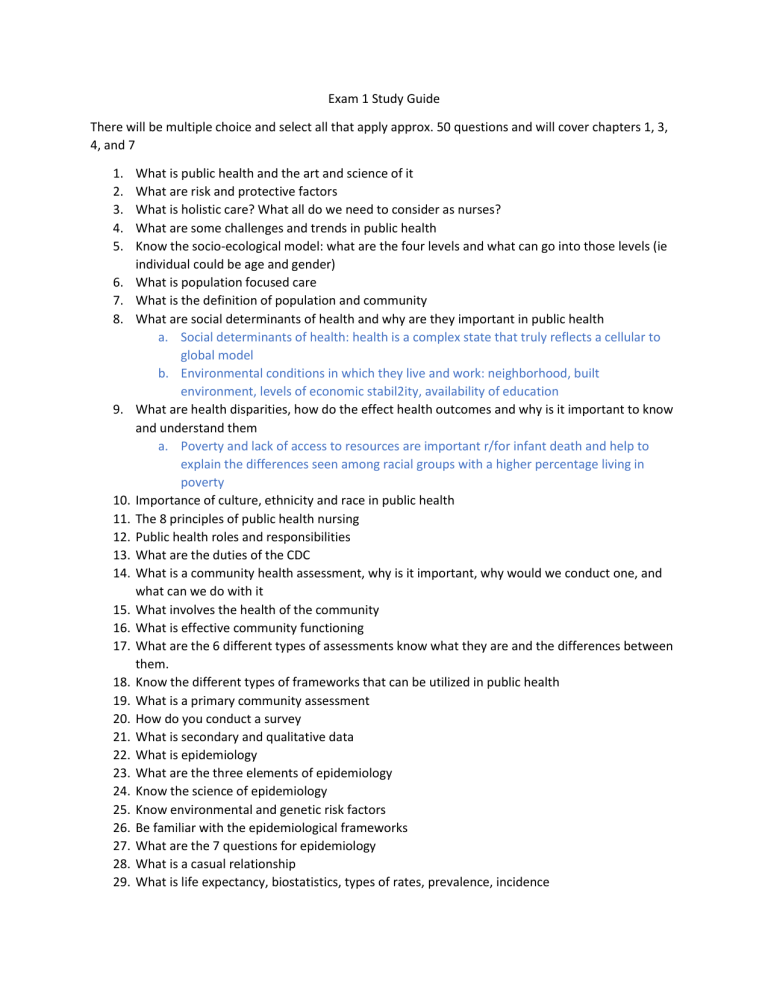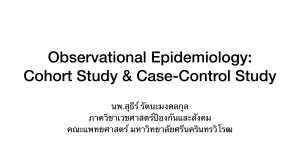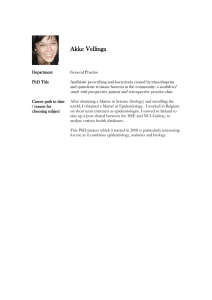
Exam 1 Study Guide There will be multiple choice and select all that apply approx. 50 questions and will cover chapters 1, 3, 4, and 7 1. 2. 3. 4. 5. 6. 7. 8. 9. 10. 11. 12. 13. 14. 15. 16. 17. 18. 19. 20. 21. 22. 23. 24. 25. 26. 27. 28. 29. What is public health and the art and science of it What are risk and protective factors What is holistic care? What all do we need to consider as nurses? What are some challenges and trends in public health Know the socio-ecological model: what are the four levels and what can go into those levels (ie individual could be age and gender) What is population focused care What is the definition of population and community What are social determinants of health and why are they important in public health a. Social determinants of health: health is a complex state that truly reflects a cellular to global model b. Environmental conditions in which they live and work: neighborhood, built environment, levels of economic stabil2ity, availability of education What are health disparities, how do the effect health outcomes and why is it important to know and understand them a. Poverty and lack of access to resources are important r/for infant death and help to explain the differences seen among racial groups with a higher percentage living in poverty Importance of culture, ethnicity and race in public health The 8 principles of public health nursing Public health roles and responsibilities What are the duties of the CDC What is a community health assessment, why is it important, why would we conduct one, and what can we do with it What involves the health of the community What is effective community functioning What are the 6 different types of assessments know what they are and the differences between them. Know the different types of frameworks that can be utilized in public health What is a primary community assessment How do you conduct a survey What is secondary and qualitative data What is epidemiology What are the three elements of epidemiology Know the science of epidemiology Know environmental and genetic risk factors Be familiar with the epidemiological frameworks What are the 7 questions for epidemiology What is a casual relationship What is life expectancy, biostatistics, types of rates, prevalence, incidence 30. What are breakout investigations, risk factors, and surveillance 31. Health equity vs. equality 32. What is vulnerability and what are some vulnerable populations a. Vulnerability: the degree to which and individual, population or organization is unable to anticipate, cope with, resist, and recover from the impact of disease and disasters b. Based on race, age, ethnicity, sexual orientation, socioeconomic status, exposure of violence, lack of permanent residence, gender 33. What are health and social gradients a. Health Gradients: a series of progressively increasing or decreasing differences between populations i. Reflects the relationship between health and income at the population level with health gradually improving as income improves b. Social Gradient: health inequities effect everyone 34. Know the differences in homelessness and impact on health a. 35. Know the impact on health for those in poverty, incarcerated and the LGBTQ communities



